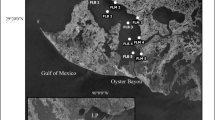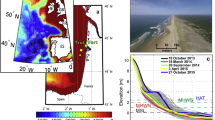Abstract
Boat-based field data and monitoring station data from the tidal reach of the Mississippi River are utilized to examine the sediment capture of large (>1,400 cms) proposed water and sediment diversions from the channel to build and sustain wetlands in the Mississippi delta. The purpose herein is to suggest the importance of siting the diversion relative to river morphology and operating it to optimize sediment capture. At the site of a proposed diversion near Myrtle Grove, LA, water and sediment data suggest that the washload (fine) fraction is strongly weighted toward the rising limb of individual freshets (e.g., flows >16,990 cms, 1 to 5 events/y over the last 49 y) based on daily turbidity records. Significant variability in suspended fines exists between freshets depending on whether they are the first peak of the water year, and on their tributary source. Much of the sand fraction in suspended load, since it is derived from the underlying bed (e.g., bed material load), is strongly tied to water discharge in this reach, and can be accurately predicted by ratings curve. An analytical model is presented that is utilized to test efficiency of sand capture in a diversion based on ADCP backscatter data calibrated by isokinetic water samplers. Using observations from the diversion site, the model predicts a 30 % more efficient sand capture for a 1,416 cms diversion (0–10 m withdrawal depth) at a discharge of 27,250 cms (March 2011) on the proposed lateral bar diversion site, relative to a thalweg site on the opposite bank. This suggests that the proximity of large dunes, and the turbulence induced by them, is a primary control on sand resuspension in the water capture zone, which in turn plays a strong role in efficiency of diversion sand capture.





Similar content being viewed by others
References
Allison MA, Meselhe EA (2010) The use of large water and sediment diversions in the lower Mississippi river (Louisiana) for coastal restoration. J Hydrol 387:346–360
Allison MA, Vosburg BM, Ramirez MT, and Meselhe EA (2013) Mississippi River channel response to the Bonnet Carre Spillway opening in the 2011 flood and its implications for the design and operation of river diversions. Journal of Hydrology. http://dx.doi.org/10.1016/j.jhydrol.2012.11.011
Barras J (2006) Land area change in coastal Louisiana after the 2005 hurricanes: a series of three maps. U.S. Geological Survey Open File Report 06–1274.
Blum MD, Roberts HH (2012) The Mississippi delta region: past, present, and future. Annu Rev Earth Planet Sci 40:655–683
Boesch DF, Josselyn MN, Mehta AJ, Morris JT, Nuttle WK, Simenstad CA and Swift DJP (1994) Scientific Assessment of Coastal Wetland Loss, Restoration and Management in Louisiana. Journal of Coastal Research Special Issue No. 20, 103 p.
Coleman JP (1988) Dynamic changes and processes in the Mississippi river delta. Geol Soc Am Bull 100:999–1015
Couvillion BR, Beck H (2013) Marsh collapse thresholds for coastal Louisiana estimated using topography and vegetation index data. J Coast Res Spec Issue 63:58–67
Day JW, Shaffer GP, Britsch LD, Reed DJ, Hawes SR, Cahoon D (2000) Pattern and process of land loss in the Mississippi delta: A spatial and temporal analysis of wetland habitat change. Estuaries 23(4):425–438
Day JW, Boesch DF, Clairain EJ, Mitsch WJ, Orth K, Mashriqui H, Reed DJ, Shabman L, Simenstad CA, Streever BJ, Twilley RR, Watson CC, Wells JT, Whigham DF (2007) Restoration of the Mississippi Delta: lessons from Hurricanes Katrina and Rita. Science 315:1679–1684
Day JW, Cable JE, Cowan R, DeLaune R, Fry B, Mashriqui H, Justic D, Kemp P, Lane RR, Rick J, Rick S, Rozas LP, Snedden G, Swenson E, Twilley RR, Wissel B (2009) The impacts of pulsed reintroduction of river water on a Mississippi delta coastal basin J. Coast Res 54:225–243
Day J, Ibanez C, Scarton F, Pont D, Hensel P, Day J, Lane R (2011) Sustainability of Mediterranean deltaic and lagoon wetlands with sea-level rise: the importance of river input. Estuar Coasts 34:483–493
Duan SW, Bianchi TS (2006) Seasonal changes in the abundance and composition of plant pigments in particulate organic carbon in the lower Mississippi and Pearl rivers (USA). Estuar Coasts 29:427–442
Duan S, Bianchi TS, Santschi PH, Amon RMW (2010) Effects of tributary inputs on nutrient export from the Mississippi and Atchafalaya rivers to the Gulf of Mexico. Mar Freshw Res 61:1029–1038
Fan H, Huang H, Zeng T (2006) Impacts of anthropogenic activity on the recent evolution of the Huanghe (yellow) river delta. J Coast Res 224:919–929
Galler JJ, Allison MA (2008) Estuarine controls on fine-grained sediment storage in the lower Mississippi and Atchafalaya rivers. Geol Soc Am Bull 120:386–398
Heidel SG (1956) The progressive lag of sediment concentration with flood waves. Trans Am Geophys Union 37:56–66
Kamruzzaman M, Beecham S, Zuppi GM (2012) A model for water sharing in the Ganges river basin. Water Environ J 26:308–318
Kliot N, Shmueli D, Shamir U (2001) Institutions for management of transboundary water resources: their nature, characteristics and shortcomings. Water Policy 3:229–255
LACPRA (2012) Louisiana’s Comprehensive Master Plan for a Sustainable Coast. published by the Lousisiana Coastal Protection and Restoration Authority (LACPRA), State of Louisiana, Baton Rouge, LA, 170 pp.
Liao Z, Hannam PM (2013) The Mekong game: achieving an all-win situation. Water Res Management 27:2611–2622
Meselhe EA, Georgiou I, Allison MA, McCorquodale JA (2012) Myrtle Grove delta building diversion: numerical modeling of hydrodynamic and sediment transport in the lower Mississippi near myrtle grove river bend. J Hydrol 472–3:340–354
Meselhe E, McCorquodale JA, Shelden J, Dortch M, Brown TS, Elkan P, Rodrigue MD, Schindler JK, Wang Z (2013) Eco-hydrology component of Louisiana’s 2012 coastal master plan: mass-balance compartment model. Journal of Coastal Res Special Issue 67:16–28
Morton R, Bernier J, Barras J (2006) Evidence of regional subsidence and associated interior wetland loss induced by hydrocarbon production, Gulf coast region, USA. Environ Geol 50:261–274
Neph HM, Vivoni ER (2000) Flow structure in depth-limited, vegetated flow. J Geophys Res 105:29547–28557
Nittrouer JA, Mohrig D, Allison MA (2011) Punctuated sand transport in the lowermost Mississippi river. J Geophys Res Earth Surf Process 116, F04025. doi:10.1029/2011JF002026
Penland S, Williams SJ, Davis DW, Sallenger AH Jr, Groat CG (1992) Barrier island erosion and wetland loss in Louisiana. atlas of shoreline changes in Louisiana from 1985 to 1989. U.S. geological survey. Misc Investig I-1250A:2–7
Peyronnin NS, Green M, Richards CP, Owens A, Reed D, Groves D, Chamberlain J, Rhinehart K, Belhadjali K (2013) Louisiana’s 2012 coastal master plan: overview of a science-based and publicly-informed decision making process. Journal of Coastal Res Special Issue 67:1–15
Ramirez MT (2011) Suspension of bed material over lateral sand bars in the lower Mississippi River, Southeastern Louisiana, M.S. thesis, University of Texas at Austin, 120 p.
Ramirez MT, Allison MA (2013) Suspension of bed material over sand bars in the lower Mississippi river and its implications for Mississippi delta environmental restoration. J Geophys Res Earth Surf Process. doi:10.1002/jgrf.20075
Reed DJ (2002) Sea-level rise and coastal marsh sustainability: geological and ecological factors in the Mississippi delta plain. Geomorphology 48:233–243
Rees TF, Ranville JF (1990) Collection and analysis of colloidal particles transported in the Mississippi river, USA. J Contam Hydrol 6(3):241–250
Restrepo JD, Kettner A (2012) Human induced discharge diversion in a tropical delta and its environmental implications: the Patia river. Columbia J Hydrol. doi:10.1016/j.jhydrol.2011.12.037
Roberts HH (1997) Dynamic changes of the Holocene Mississippi delta plain: the delta cycle. J Coast Res 13:605–637
Rouse H (1937) Modern conceptions of the mechanics of fluid turbulence. Trans Am Soc Civ Eng 102:463–543
Syvitski JPM, Kettner AJ, Overeem I, Hutton EWH, Hannon MT, Brakenridge GR, Day J, Vorosmarty C, Saito Y, Giosan L, Nicholls RJ (2009) Sinking deltas due to human activities. Nat Geosci. doi:10.1038/NGEO629
Van Heerden IL, Roberts HH (1988) Facies development of Atchafalaya delta louisiana: a modern bayhead delta. AAPG Bull 72:439–453
Van Sickle J, Beschta RL (1983) Supply-based models of suspended sediment transport in systems. Water Resour Res 19:768–778
Walling DE (1977) Limitations of the rating curve technique for estimating suspended sediment loads, with particular reference to British rivers. Proc. of the Paris symposium. Int Assoc Sci Hydrol 122:34–38
Xia C, Pahl-Wostl C (2012) The development of water allocation management in the yellow river basin. Water Res Manag 26:3395–3414
Zhang E, Savenije HHG, Chen S, Chen J (2012) Water abstraction along the lower Yangtze river, China, and its impact on water discharge into the estuary. Phys Chem Earth 47–48:76–85
Author information
Authors and Affiliations
Corresponding author
Electronic supplementary material
Below is the link to the electronic supplementary material.
ESM 1
(PDF 488 kb)
Rights and permissions
About this article
Cite this article
Allison, M.A., Ramirez, M.T. & Meselhe, E.A. Diversion of Mississippi River Water Downstream of New Orleans, Louisiana, USA to Maximize Sediment Capture and Ameliorate Coastal Land Loss. Water Resour Manage 28, 4113–4126 (2014). https://doi.org/10.1007/s11269-014-0731-y
Received:
Accepted:
Published:
Issue Date:
DOI: https://doi.org/10.1007/s11269-014-0731-y




